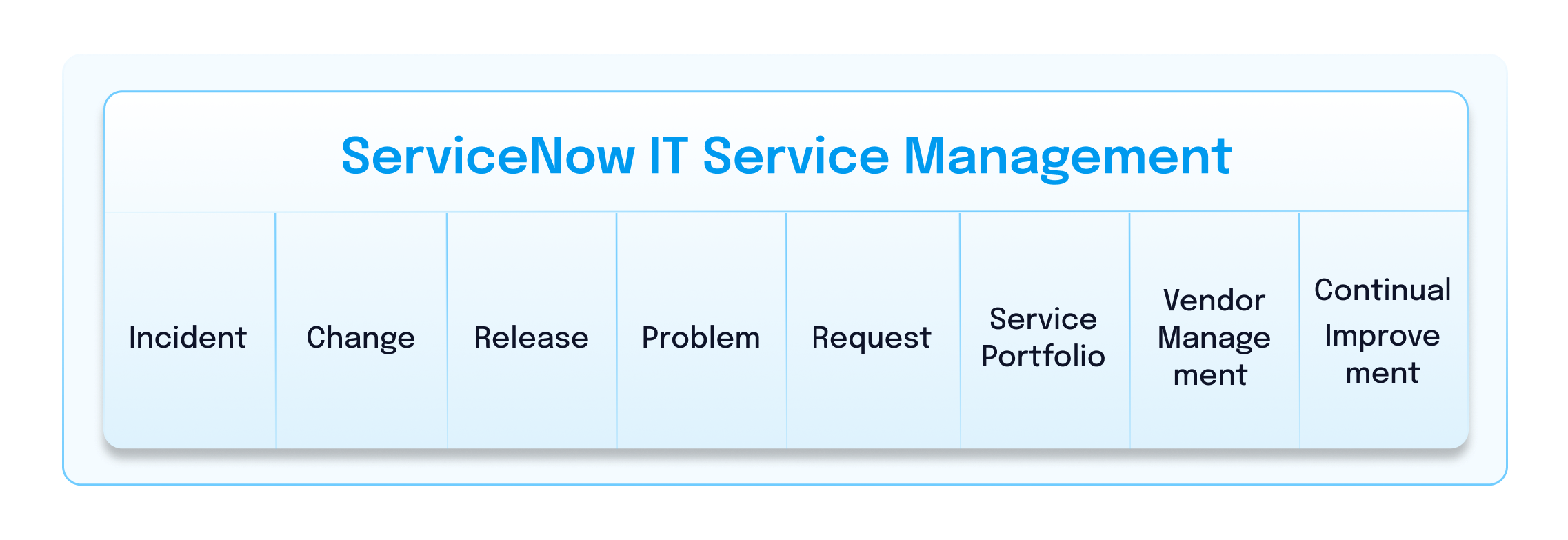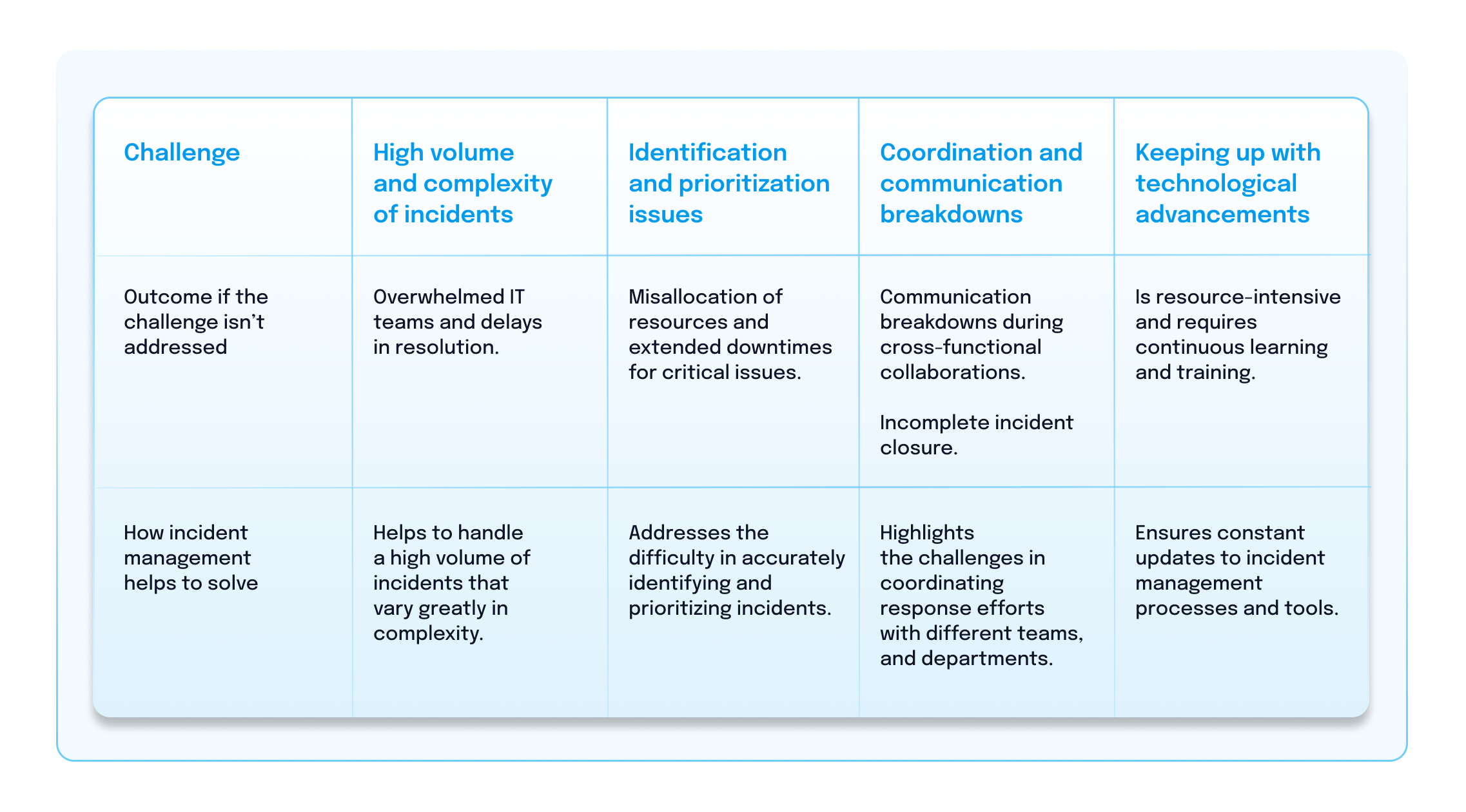You’re focused on swiftly identifying, analyzing, and resolving disruptions in IT services. And you know all too well that correctly deploying and adopting incident management holds the key to delivering a more reliable and responsive IT environment for your applications and services.
That’s why you’re using or are considering using ServiceNow’s incident management to ensure a structured and efficient approach to handling your IT service incidents.
So if you’re looking to maximize your ServiceNow incident management investment, you’ve come to the right place. We’ll cover everything you need to know, from the specifics of ServiceNow’s approach to incident management to its main features and benefits. Read on to learn about:
- What is ServiceNow Incident Management?
- Why does incident management matter?
- What’s the difference between incident management and problem management?
- What are the main features of ServiceNow Incident Management?
- What are the benefits of Using ServiceNow for Incident Management?
- Implementing and configuring Incident Management in ServiceNow
- What are the challenges of IT Incident Management?
- How BigPanda AIOps enhances ServiceNow Incident Management
- Autodesk: A BigPanda and ServiceNow Case Study
Discover how ServiceNow Incident Management is a critical component of IT service management (ITSM) and ensures uninterrupted IT services, minimal business operational impact, and rapid digital transformation and deployment.
What is ServiceNow Incident Management?
ServiceNow Incident Management is a component within the ServiceNow IT Service Management (ITSM) platform that allows organizations to log, track, manage, and resolve incidents impacting their IT services.
It aligns with Information Technology Infrastructure Library (ITIL) principles and automates the incident resolution process to ensure quick response to disruptions and maintain service continuity.
The ServiceNow ITSM also works with the ServiceNow IT Operations Management (ITOM) platform, which manages and optimizes IT infrastructure and operations to ensure the reliability, availability, and performance of IT services.
Why does incident management matter?
Incident management minimizes the impact of IT incidents on business operations. Organizations can reduce downtime, maintain high service levels, and ensure a consistent and effective response to IT issues to support overall business continuity and productivity by providing a structured and efficient approach to incident handling.
What’s the difference between incident management and problem management?
Incident management in ITOps is distinct from problem management. IT incident management focuses on quickly resolving individual IT issues to restore normal service operations as soon as possible.
Problem management, on the other hand, aims to identify, analyze, and remove the root causes of recurring incidents to prevent future disruptions.
What are the main features of ServiceNow Incident Management?
There are 12 features in ServiceNow Incident Management. However, the four most critical are major incident management, single-pane agent view, AI-powered insight, and the native mobile application.
- Major incident management: Uses embedded workflows to identify, track, and resolve high‑impact incidents. Enables the proper classification and prioritization of incidents by severity and impact for effective management.
- Single-pane agent view: A centralized hub for agents to manage incidents. It provides a comprehensive view of ongoing issues and offers recommendations on resolution, allowing IT staff to track, prioritize, and resolve incidents efficiently.
- AI-powered insight: Leverages Artificial Intelligence (AI) to suggest solutions based on historical data to speed up the resolution process. It helps IT personnel to quickly identify the most effective responses to incidents, reduce downtime, and improve overall service quality.
- Native mobile application: ServiceNow offers mobile applications that enable IT staff to triage, address, and resolve incidents wherever they are, allowing for timely responses regardless of location.
Additional features include an AIOps integration, omnichannel notifications, incident response playbook, on-call scheduling, visual task boards, a single system of record, calculated priority, and guided setup. ServiceNow incident management can also integrate with third-party tools to boost operational efficiency within an organization’s broader IT ecosystem.
What are the benefits of using ServiceNow incident management?
Using ServiceNow for incident management offers benefits, including simplified incident resolution processes, reduced downtime, and improved IT service efficiency and reliability.
- Report and resolve IT service interruptions: Users can create incidents in ServiceNow to report issues like email service disruptions or hardware/software malfunctions. ServiceNow facilitates the quick submission of these incidents via various methods such as email, self-service portals, or direct submission by IT service desk staff. This reporting ensures no incident goes unnoticed and can be addressed promptly.
- Effectively manage incident lifecycles: ServiceNow’s incident management process is responsible for managing the entire lifecycle of incidents. It provides tools for incident recognition (by technical staff or monitoring tools), communication (via service desk or third-party reports), and resolution. The system’s handling of these phases helps to restore regular service operation as quickly as possible.
- Minimize adverse business impact: By aiming to restore normal service operations rapidly and maintaining agreed levels of service quality, ServiceNow helps minimize the negative effects of IT incidents on business operations. This mitigation is crucial for maintaining business continuity and customer satisfaction.
- Identify and address root causes: ServiceNow enables the creation of problem or change requests related to incidents. If multiple incidents share a common cause, a problem can be created for root cause analysis. Similarly, if an incident exposes a need for changes in IT infrastructure, a change request can be initiated.
- Streamline assignment and resolution process: Once an incident is reported, ServiceNow’s system can automatically assign it to the appropriate group or user based on predefined rules. This automation ensures the relevant parties promptly attend to incidents. Additionally, the system provides tools for categorizing, prioritizing, and attaching knowledge articles to incidents, facilitating efficient resolution.
Implementing incident management in ServiceNow
Implementing incident management in ServiceNow begins with setting up the Incident Management module in the ServiceNow platform. Set-up involves defining the processes and rules for handling IT incidents. This includes configuring how incidents are categorized, prioritized, and assigned to the appropriate IT support team.
You can create templates for common incident types to streamline the reporting process, ensuring that it can be logged quickly and accurately when an incident occurs. The system then automatically routes these incidents to the relevant team based on predefined criteria like incident type, urgency, and impact. ServiceNow tracks and manages all activities throughout the incident lifecycle, from reporting to resolution, with real-time updates and analytics.
This setup enables a structured and efficient approach to handling IT disruptions, ensuring minimal impact on services and users. Think of it like a detailed, automated to-do list that helps IT teams fix problems systematically and prevent them from happening again.
What are the challenges of IT incident management?
Conducting your incident management in ServiceNow allows you to tackle the common issues of IT incident management, including:
How BigPanda AIOps enhances ServiceNow Incident Management
Most organizations rely on multiple monitoring tools. Most enterprises have 20+ across infrastructure, networking, database, APM and more, each of which produces thousands of daily alerts. Without robust event correlation, each alert often leads to a new ServiceNow ticket, causing a single incident to generate numerous redundant tickets that overwhelm response teams.
BigPanda AIOps elevates ServiceNow incident management by employing AI, machine learning, and automation to accelerate response times and lessen the burden on IT staff.
Many alerts and the corresponding tickets they produce lack contextual information vital to speedy incident response. This makes it time-consuming for service desk teams to manually review alerts, assess the impact, and decide on the appropriate escalation path.
- Automate your service ticket lifecycle for better incident management: BigPanda automatically creates tickets in ServiceNow based on the high-level incidents in BigPanda. For example, BigPanda correlates multi-source alerts, enriches the data with topology, CMDB, and change data, and creates a single ticket in ServiceNow. Our integration also can reduce the number of overall tickets per incident because whenever new events and alerts are correlated to the same incident, we can update the existing ticket in real-time without creating a new one.
- Enrich and augment your CMDB: ServiceNow’s CMDB keeps a record of the assets in your IT environment and their configuration data. In dynamic environments, keeping this change management database up to date can be hard. Our integration allows you to enrich alerts coming into BigPanda with information from your existing ServiceNow CMDB, but augment it with topology, CI/CD, and change data from other sources, creating a more comprehensive view of dynamic environments that make event correlation more impactful.
- Correlate incidents with changes: BigPanda ServiceNow Changes integration helps BigPanda consume the change records created or updated in ServiceNow’s change module. BigPanda’s Root Cause Changes capability analyzes this change data alongside monitoring alerts and topology data using machine learning to identify the change(s) that caused an incident or outage. The integration proactively notifies BigPanda of any new or updated changes in your ServiceNow Change Management system. It also syncs with maintenance window information, automatically suppressing alerts during these windows to reduce noise.
Autodesk: A BigPanda and ServiceNow Case Study
Before working with BigPanda, Autodesk’s ITOps team struggled with 100,000 monthly application alerts from 25 tools, overwhelming the NOC’s capacity to filter actionable insights.
Juggling multiple dashboards for each incident increased manual work and delayed root cause analysis. Poorly contextualized ServiceNow tickets, requiring manual input, led to misdirected assignments and prolonged resolution times. Autodesk adopted BigPanda’s platform for better intelligence and automation, utilizing features like:
- Contextual data with custom tags
- Environments and groups
- Smart ticketing with Auto Sharing
- Analytics and snapshot
Learn how Autodesk reduced incidents by 69% and improved MTTR by 85% using these features from BigPanda.
Discover how the BigPanda ServiceNow Integration adds critical AIOps context
ServiceNow incident management helps to resolve IT issues and streamline operations swiftly. The BigPanda ServiceNow integration enhances incident management by adding crucial AIOps context, utilizing AI and machine learning to analyze and correlate alerts, thereby reducing ticket noise and pinpointing the root causes of incidents. With BigPanda you can:
- Automate your service ticket lifecycle for better incident management
- Enrich and augment your CMDB
- Correlate incidents with changes
Ready to explore how BigPanda integrated with ServiceNow can revolutionize your incident management process?
See for yourself in our personalized demo how BigPanda lets you gain enriched, actionable insights directly into ServiceNow tickets, enabling quicker, more informed decision-making and efficient incident resolution.







